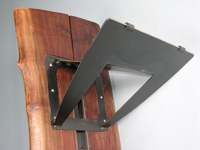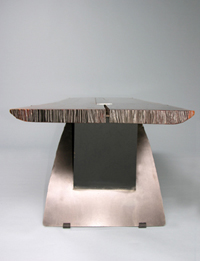|
*OREV BENCH N51
>
Project advisor Professor Chris Dewart The plan was to create a very planar, graphical looking bench, made of surfaces and 'lines' with various thicknesses. The assumption made in the initial sketches was that the top / sitting surface will be made of 2 wood boards (boards purchased from local lumber yard, cut and glued to the needed size) and the legs will be made of bent metal sheets. However, no two wooden boards are alike, and that was certainly the case with the ones with which I wanted to work. A walnut board was leaning at the end of the wood shop, and I always thought it's off limits - a 6 feet long (180cm), 24" wide (61cm), 1.75" (4.5cm) thick section through the center of a walnut tree. I showed the sketches to Chris and asked about the walnut. He replied that a former student purchased it in Pennsylvania and brought it with him to California. Two years later he moved to Massachusetts. After graduating from MIT he decided not to take it cross-country any more and sold it to Chris. The board was leaning in the corner of the wood shop for over 10 years and was even flooded few times. Much to my delight, Chris said I can buy it for this project. It was very clear very early that one has to work with material like this, closely investigate the marks on the board and let them guide or modify some of the previously made design decisions. The process was organic, it entailed co-designing with the material. As the center core of the walnut board was damaged (see top-left photo below), the board was cut in half and its center part was routed / removed. A U-shaped steel profile connected the 2 parts of the board back together.
Photos clockwise: The core of the wooden board was damaged and removed. Top right photo: The legs were made from 3/8" iron sheet, cut on a water jet cutter; the center part was bent with flaming. Bottom right photo: The legs were welded onto 11"x11"steel plates with which they were then attached to the wooden boards. The bottom side of the boards was routed 1/8" and the iron plates were 'flushed'. The last image (bottom left) shows the connection between the metal leg and the wooden board. The ends of the walnut board had very deep chain saw marks. These marks were kept -- they were part of the history of the tree and now the bench.
I have tried playing with electroluminescent light wire several times and was never satisfied with the results. For this project I wanted two thin, parallel red lines of light to run along the center of the bench, in-between the steel and wooden boards. These lines resemble blood vessels and can be seen in the dark. It was worthwhile investigating if electroluminescent light wire will work, and the result was great. Lexan (3/8" thick) was used as a spacer, holder of the light wire and as a light diffuser. The light wire is powered either with 2 AA batteries or with adapter. The controller (needed to turn the wire on / off) is located at one end of the bench, and fits inside the U-shaped iron profile.
The walnut boards are finished with multiple coats of linseed oil, satin (no gloss) polyurethane, and iron wool as a final polish (very smooooth!) This bench can be easily reproduced in large series. Its components are very simple, planar elements. The object can be used both outdoors and indoors, and can be easily spotted in the dark. Each bench will have unique characteristics due to the shape / length of the boards and use of specific wood specie, as well as color of light. The size of the bench is H 17" (44cm), W between 20"-24", L approximately 6' (180cm). Materials: *OREV
means "walnut" in Macedonian.
|
|
welcome
|
|
courses
|
|
folio |
|
papers
|
|
exhibits |
|
CV
|
|
PHOTOS by Kate Kunath 2005











